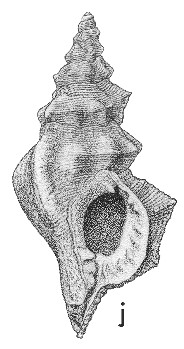
Revised descriptions of New Zealand Cenozoic Mollusca from Beu and Maxwell (1990)

 | Revised descriptions of New Zealand Cenozoic Mollusca from Beu and Maxwell (1990) | 
|
  (Pl. 24j): holotype, Pakaurangi Point, Kaipara Harbour, Altonian (TM1261, GNS) |
Beu & Maxwell (1990): Chapter 11; p. 223; pl. 24 j.
Synonymy: Austrosassia zealta Laws 1939a, p. 490; Sassia (Sassia) zealta, Beu & Maxwell 1990, p. 223, pl. 24j.
Classification: Ranellidae: Cymatiinae
Description: Very large for subgenus (height 53-106 mm), tall and moderately narrow, spire about half total height. Protoconch as in S. maoria (P1. 20o) but a little taller. Teleoconch whorls taller and narrower than in S. tortirostris or the S. maoria-parkinsonia group, strongly angled (near middle on spire) by a peripheral row of large, pointed, vertically compressed nodules, present also on varices. Varices high, narrow, at each 0.67 whorl down whole teleoconch. Sculpture of 3 major spiral cords on last whorl (extending onto varix and angulating whorl surface), very low, narrow and widely spaced; uppermost bearing peripheral spines, middle one bearing low nodules, and lowest one finely gemmate. Remainder of surface bearing many closely spaced, fine, finely gemmate spiral cords and growth ridges. Aperture oval, siphonal canal long (at least as long as aperture), narrow, almost straight. Inner lip callus thin but with raised rim, smooth except for a few basal ridges; outer lip with 7 low nodules within on small shells, but these become low and obscure on adults.
Comparison: Laws' holotype of "Austrosassia" zealta proves to be a small shell (height 53 mm) of a large, sharply nodulose species, and although shells from the different localities listed under "Distribution" are all subtly different they seem best regarded as one species. Even larger, Charonia-like shells (up to 120-150 mm high) are not uncommon at some Oligocene localities (particularly Wharekuri Greensand, head of Lake Waitaki, Duntroonian) and a single, incomplete, enormous specimen has been collected with S. zealta at Beach Road, South Oamaru (Altonian); they have lower and more rounded nodules than S. zealta. As noted by Beu & Maxwell (1990, p. 426), the name S. minima applies to the Oligocene species, and the Beach Road shell appears to be an unnamed descendent. Small, elongate shells from McCulloch's Bridge, South Canterbury (Kaiatan) and Waihao Downs (Bortonian) represent an Eocene member of the group. The species group is also represented outside New Zealand by S. abbotti (T. Woods, 1876) (Early Miocene, northern Tasmania) and by Oligocene specimens of S. minima in Victoria, Australia, by the Chilean Miocene S. armata (Hupé, 1854), and by the Patagonian Oligocene S. morgani (Ortmann, 1900) and S. bicegoi (Ihering, 1899).
Distribution: Otaian-Clifdenian; Pakaurangi Formation, Pakaurangi Point, Kaipara Harbour, Otaian and Altonian (type); Coral Point, Kaipara (Otaian); Paratoetoe Formation, Paratoetoe and Te Pokere, Parengarenga Harbour; Mount Harris Formation, Bluecliffs, Otaio River; Clifden (Calamity Point Sandstone to basal Slip Point Siltstone); Mount Harris Formation, South Oamaru (rare).
Cite this publication as: "A.G. Beu and J.I. Raine (2009). Revised
descriptions of New Zealand Cenozoic Mollusca from Beu and Maxwell (1990). GNS
Science miscellaneous series no. 27."
© GNS Science, 2009
ISBN
978-0-478-19705-1
ISSN 1177-2441
(Included with a PDF facsimile file
copy of New Zealand Geological Survey Paleontological Bulletin 58 in CD version
from: Publications Officer, GNS Science, P.O. Box 30368 Lower Hutt, New
Zealand)